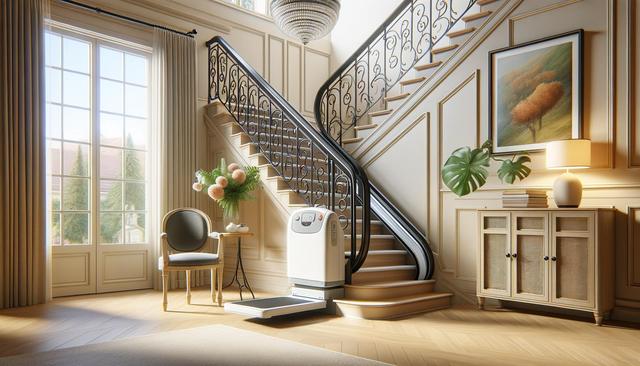Understanding the Purpose of Stair Lifts
For many seniors, aging in place is a preferred lifestyle choice. However, one of the most common challenges faced in multi-story homes is navigating stairs safely. Stair lifts, which are motorized chairs attached to a rail system that moves up and down a staircase, are designed to eliminate this concern. These devices allow elderly individuals to maintain independence while reducing the risk of falls — a leading cause of injury among older adults. By offering a stable and controlled method of stair navigation, stair lifts contribute greatly to home safety and accessibility.
Stair lifts come in various models to accommodate different types of staircases, including straight, curved, and outdoor options. Each model is typically equipped with safety features such as seat belts, swivel seats, footrests, and sensors that detect obstacles on the stairs. These functions ensure that users have a secure and comfortable ride each time. As homes become more adapted to the needs of aging occupants, stair lifts are increasingly recognized as a practical solution for safer mobility.
Benefits of Installing a Stair Lift for Seniors
Installing a stair lift offers numerous advantages beyond basic mobility. One of the most significant benefits is the enhancement of personal safety. According to various health studies, stair-related accidents are a major concern for seniors, particularly those with conditions like arthritis, balance disorders, or limited vision. A stair lift helps eliminate this risk by providing a smooth and reliable transport system between floors.
Additional benefits include:
- Improved independence, reducing the need for constant caregiver assistance.
- Greater confidence in moving around the home freely.
- Potential to stay longer in one’s own home rather than relocating to a single-story dwelling or assisted living facility.
- Convenience for caregivers, who no longer need to assist with physically demanding stair navigation.
These benefits collectively contribute to a higher quality of life for seniors, helping them maintain their routines and lifestyles with fewer limitations.
Factors to Consider Before Purchasing
Before installing a stair lift, it’s important to assess several key factors to ensure it suits the user’s needs and the home’s layout. The first consideration should be the type of staircase. Straight staircases typically require less customization and are more affordable, while curved or spiral staircases may need tailored solutions, which can increase the cost and installation time.
Other important considerations include:
- Weight capacity: Ensure the stair lift supports the user’s weight safely.
- Seat and armrest adjustability for comfort and ease of use.
- Battery backup in case of a power outage.
- Ease of control via remote or onboard buttons.
- Warranty and availability of service or maintenance.
Consulting with a professional installer can help determine the most suitable model and ensure compliance with safety standards, which is essential for long-term reliability.
Installation and Maintenance Insights
The installation process for a stair lift is generally straightforward and can often be completed within a day, depending on the complexity of the staircase. Professional installers evaluate the space, take precise measurements, and secure the rail system to the staircase itself—not the wall—preventing any structural damage. Once installed, they test the unit thoroughly and instruct the user on proper operation and safety practices.
Regular maintenance is key to keeping the stair lift in optimal condition. Most manufacturers recommend routine checks every six to twelve months. Basic maintenance tasks may include:
- Cleaning the track to prevent dust buildup.
- Inspecting moving parts for wear and tear.
- Checking battery condition and replacing it when necessary.
- Ensuring that safety sensors and seat belts are functioning properly.
Following a regular maintenance schedule not only extends the lifespan of the stair lift but also ensures consistent safe operation.
Cost and Funding Options
While stair lifts can represent a meaningful investment, many families find the cost worthwhile when considering the safety and independence it provides for their loved ones. Prices vary based on factors such as stair configuration, additional features, and brand preferences. Straight stair lifts typically fall on the lower end of the price range, whereas curved versions may require custom-built tracks, increasing the total cost.
Fortunately, there are several ways to manage the expense. Some potential funding sources include:
- Private insurance policies that may partially cover mobility aids.
- Home modification grants for seniors offered by local or national organizations.
- Medical financing programs or payment plans provided by installation companies.
- Tax deductions for medically necessary home improvements, depending on jurisdiction.
Exploring these options can help make stair lifts more accessible to those who need them. It’s advisable to request multiple quotes and consult with a healthcare provider or occupational therapist to justify the need for a stair lift, which may further aid in securing financial assistance.
Conclusion: Enhancing Senior Safety at Home
For aging individuals who wish to remain in their homes safely and comfortably, stair lifts offer a valuable solution. By addressing one of the most hazardous areas in the home—staircases—they reduce the risk of injury and promote continued independence. While there are several factors to consider, including cost, installation, and ongoing maintenance, the long-term benefits often outweigh the initial effort and expense. Families and caregivers seeking to create a safer living environment for seniors may find that stair lifts are a practical and effective addition to the home.




Leave a Reply